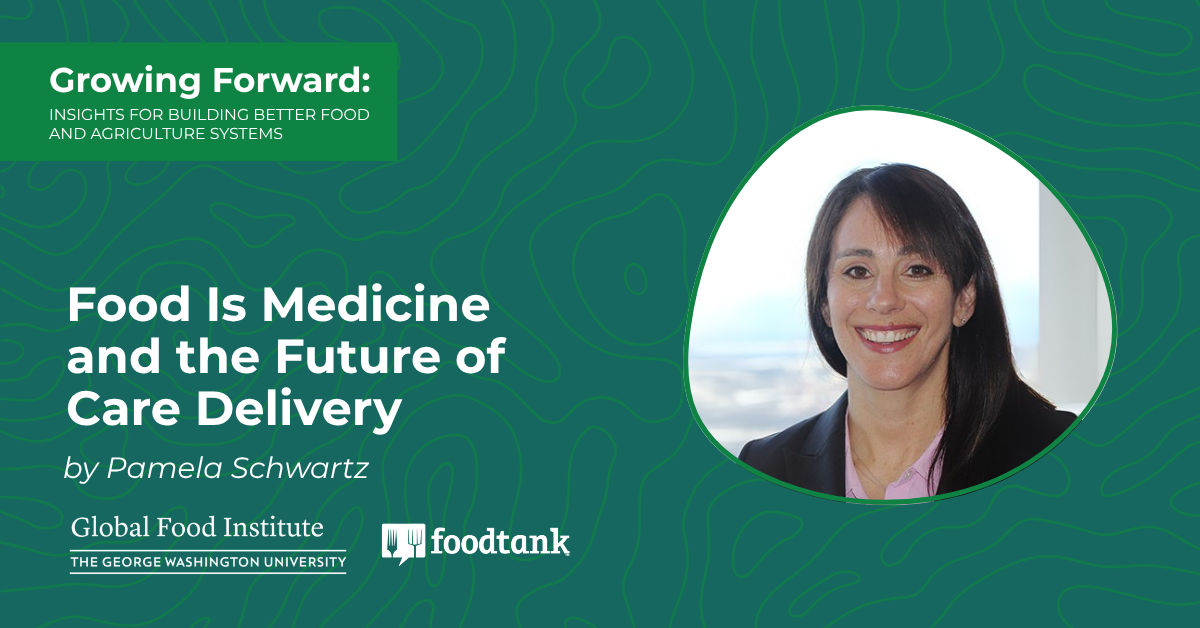This piece is part of the weekly series “Growing Forward: Insights for Building Better Food and Agriculture Systems,” presented by the Global Food Institute at the George Washington University and the nonprofit organization Food Tank. Each installment highlights forward-thinking strategies to address today’s food and agriculture related challenges with innovative solutions. To view more pieces in the series, click here.
Despite the central role nutrition plays in preventing and managing disease, U.S. medical schools currently devote, on average, fewer than 20 hours to nutrition education over the course of four years. This limited exposure stands in stark contrast to the outsized impact that diet has on health; indeed, diet-related disease remains the leading cause of death in the United States. This educational gap is one of several systemic barriers that limit physicians’ capacity to effectively address diet-related diseases and promote healthy eating habits among their patients.
But that is starting to change.
In recent years, the concept of Food Is Medicine has gained rapid momentum across the U.S. health care sector and beyond, broadening understanding of the critical role that nutrition plays in maintaining health, preventing illness, and treating many chronic conditions.
No longer a niche interest, Food Is Medicine’s core interventions—medically tailored meals, prescriptions for produce, enrollment in assistance programs, and nutrition education—have captured the zeitgeist.
Instacart launched a mission-driven arm that embraces Food Is Medicine interventions and is championing nutrition access, resources and education. advocates for nutrition policies. Private and public sector organizations have committed nearly US$10 billion to change the trajectory of diet-related disease and hunger in the U.S.
And earlier this year the Tufts Friedman School of Nutrition Science and Policy and nonprofit health system Kaiser Permanente founded the Food Is Medicine National Network of Excellence to establish standardized approaches for integrating food-based interventions into health care systems and communities. The first members of the network, some of the biggest names across health care touching millions of lives—Blue Cross and Blue Shield of North Carolina, CVS Health, Devoted Health, Elevance Health, Geisinger, and Highmark Health—are all in on Food Is Medicine.
But even with these developments—and while health systems, clinicians, academic researchers and others have been building a substantial evidence base that demonstrates Food Is Medicine’s potential to improve and save lives—Food Is Medicine is still reaching relatively few people.
One of the greatest hurdles to scaling is integrating food and nutrition into the normal course of providing and receiving health care. It continues to be seen primarily as an intervention for serious illnesses or following a hospital admission.
Getting there will require an expansive reorienting on the part of clinicians, whose advice Americans trust more than almost any other profession, and on the part of patients, whose definition of “medicine” will have to expand beyond the pharmacy window. The vast systems change this will require is one of the reasons why so many health care organizations have joined the National Network of Excellence.
So how do we get to a future state where food and nutrition are as much a part of health care as a blood pressure check?
One path is training the next generation of physicians to embrace Food Is Medicine as a foundational part of how they provide care. The Kaiser Permanente Bernard J. Tyson School of Medicine, for example, in addition to 12 hours of dedicated nutrition education, has intentionally woven it throughout the curriculum to underscore its importance across health. This includes emphasizing the connections to food when teaching about metabolic disorders, vitamin and mineral deficiencies, endocrine disorders, pregnancy, heart disease, and many other topics. Students receive instruction on related fields including scientific approaches to nutrition, food insecurity, and policy-levers to address diet-related disease; and the school offers intensive instruction through a culinary medicine elective that dedicates 120 hours to topics in nutrition and culinary literacy for the many students who want to deepen their knowledge to apply in their future practice.
Among the goals of a holistic education in Food Is Medicine strategies is to move past a model where physicians sound like chemists when discussing diet with patients, focusing on nutrients rather than providing practical counseling on meal planning and healthy eating.
This means care teams should be attuned to the wide variation in how people come to food: variables such as a person’s ability to cook or not cook; accessibility of grocery stores; whether they experience food insecurity; dietary restrictions and allergies; and traditional foodways. Then, they must employ low-barrier approaches to help patients implement lifestyle changes.
It means knowing under what circumstances a prescription for medically tailored meals, groceries or produce—often combined with nutrition education and a culinary medicine course —is likely to positively impact clinical outcomes.
And, it means grappling with the fact that food insecurity is consistently the top social health need that Americans experience, and that assistance programs like SNAP, WIC, and Summer EBT are still not reaching everyone who would benefit from them.
The good news is that we are on our way. Because of the growing enthusiasm for Food Is Medicine and the promise it shows to keep people healthier while reducing health care costs, we are on a path to achieving this reorienting in the next 5 to 10 years.
We can make that future a reality by investing now in the people who will be caring for patients tomorrow. By making nutrition curriculum and food security support a core component of medical education, we can ensure physicians have the tools and perspectives needed to unlock the evidence-based potential of food as an integral part of healthcare delivery that saves lives, reduces costs, and improves health outcomes for generations to come.
Photo courtesy of Taylor Kiser, Unsplash

